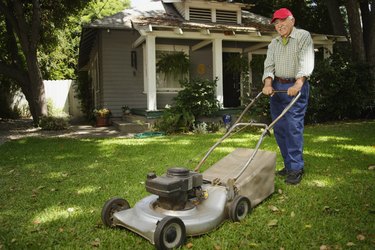
Even the most beautiful, well-manicured lawn is not immune to ruts and other depressions. Ruts are caused by everything from animals digging and heavy equipment collapsing soil to increased foot traffic in soggy areas. Diagnosis what's causing the ruts and treat, if possible before making the repair. Regardless of their cause, lawn ruts are safety hazards and eyesores. Repairing them is important to reduce the chances of someone tripping on them and to keep turf looking healthy.
Fixing Small Areas Quickly
Video of the Day
Ruts less than 4 inches deep are fast and simple to fix. Approach a rut at a 45-degree angle with a digging fork. Stick the fork into the soil just beneath the rut, and push the fork's handle with a downward motion to loosen the soil inside the rut. Fill the remaining hole with a mixture that contains equal portions of soil, sand and compost. That mixture allows good air flow and water drainage so the existing grass easily regrows over the area. If the rut already has grass, then use the digging fork to pry up the turf, fill the hole and set the turf back down over the area. The turf may sit a few inches above the grass for one or two weeks. So, until it has time to settle, be careful when mowing.
Video of the Day
Fixing Larger Areas
Ruts more than 4 inches or more deep require a little more time and patience to repair. Use an edger or slicer carefully to remove all sod around the edges or at the center of such a rut. Then loosen the soil around the rut with a digging fork. Overfill the hole by 1 or 2 inches with a mixture of equal parts soil, sand and compost. Overfilling accounts for any settling that may occur. If the removed sod is large enough, then it can be used to cover the repaired area. Otherwise, replace the removed sod with a piece that is large enough to cover the area, or reseed the area so grass will grow there again.
Sodding and Seeding
The original turf where you fixed a rut may be too damaged or unsightly to reuse. The alternatives are to seed or lay fresh sod on the repair site. Which of those options you use is completely up to your preference and the type of grass growing in the lawn, although waiting for grass to grow from seeds takes patience. If grass seeds are used, they should be sprinkled on the bare area at the rate of 0.2 ounces of seeds per 1 square foot of soil surface. Lightly rake the seeds into the soil surface, and water the area. The soil should be kept moist but not soggy for the following three to four weeks so the seeds become established and sprout.
When laying fresh sod, ensure its good contact with the soil beneath. Place a flat piece of wood over the laid sod, and walk on the board to press the sod down. Remove the board after the sod has been pressed into place. The fresh sod patch needs to be kept moist for two to three weeks, until it becomes established. When sodding or seeding an area, keep foot traffic away from the site to avoid new ruts and problems with the turf.
Repairing at the Best Time
The best time to repair ruts in a lawn depends on the type of grass. Repairing ruts is best done during the growing season when the grass is growing most actively, which depends on whether it's a cool- or warm-season variety. For warm-season grasses the most appropriate time is late spring before the heat of summer arrives. If repairing large areas of cool-season grasses, fall is the best time. Smaller ruts in cool-season grasses can be repaired during mid- to late spring. If you live in northern areas of the country, spring is also the time that you are most likely to notice ruts, holes and dips in your lawn as the snow melts and the ground thaws.